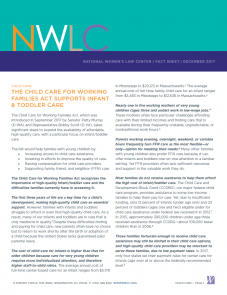
 The Child Care for Working Families Act, which was introduced in September 2017 by Senator Patty Murray (D-WA) and Representative Bobby Scott (D-VA), takes significant steps to expand the availability of affordable, high-quality care, with a particular focus on infant/toddler care. The bill would help families with young children by:
The Child Care for Working Families Act, which was introduced in September 2017 by Senator Patty Murray (D-WA) and Representative Bobby Scott (D-VA), takes significant steps to expand the availability of affordable, high-quality care, with a particular focus on infant/toddler care. The bill would help families with young children by:
- Increasing access to child care assistance.
- Investing in efforts to improve the quality of care.
- Raising compensation for child care providers.
- Supporting family, friend, and neighbor (FFN) care.
The Child Care for Working Families Act recognizes the importance of high-quality infant/toddler care and the difficulties families currently have in accessing it.
The first three years of life are a key time for a child’s development, making high-quality child care an essential support. However, families with infants and toddlers struggle to afford or even find high-quality child care. As a result, many of our infants and toddlers are in care that is only mediocre in quality. Despite these difficulties finding and paying for child care, new parents often have no choice but to return to work shortly after the birth or adoption of a child because the United States lacks guaranteed paid parental leave.
The cost of child care for infants is higher than that for older children because care for very young children requires more individualized attention, and therefore higher staff-to-child ratios. The average annual cost of full-time center-based care for an infant ranges from $5,045 in Mississippi to $17,082 in Massachusetts. The average annual cost of full-time family child care for an infant ranges from $3,394 in Mississippi to $10,679 in Massachusetts.
Nearly one in five working mothers of very young children (ages three and under) work in low-wage jobs. These mothers often face particular challenges affording care with their limited incomes and finding care that is available during their frequently unstable, unpredictable, or nontraditional work hours.
Parents working evening, overnight, weekend, or variable hours frequently turn FFN care as the most flexible—or only—option for meeting their needs. Many other families with young children also prefer FFN care because it can offer infants and toddlers one-on-one attention in a familiar setting. Yet FFN providers often lack sufficient resources and support in the valuable work they do.
Most families do not receive assistance to help them afford the high cost of infant/toddler care. The Child Care and Development Block Grant (CCDBG), our major federal child care program, provides assistance to some low-income families to help them pay for care. Yet, due to insufficient funding, only 12 percent of infants (under age one) and 23 percent of toddlers (ages one and two) eligible under for child care assistance under federal law received it in 2012. In 2015, approximately 390,000 children under age three received assistance through CCDBG—about 109,000 fewer children than in 2006.
Those families fortunate enough to receive child care assistance may still be limited in their child care options, and high-quality child care providers may be reluctant to serve these families, due to low payment rates. In 2017, only four states set their payment rates for center care for infants (age one) at or above the federally recommended level.
The Child Care for Working Families Act contains a number of specific provisions to address these challenges and support affordable, high-quality infant/toddler care.
The legislation would:
- Ensure that families earning under 150 percent of state median income, including those families with infants and toddlers, pay no more than 7 percent of their income for child care.
- Have the federal government cover a higher proportion of the costs for child care assistance for infants and toddlers (90 percent, with states contributing the remaining 10 percent) than for other age groups.
- Increase the supply of high-quality, inclusive child care for children in underserved areas, children with disabilities, and infants and toddlers with disabilities.
- Require that payment rates for child care providers serving families receiving child care assistance reflect variations in the cost of care by geographic area, type of provider, age of child, and level of quality standards met by the provider, as well as the additional cost of providing high-quality and inclusive child care for children with disabilities and infants and toddlers with disabilities.
- Require states to establish, within three years, a tiered and transparent system for measuring the quality of child care providers. The system must be developed with input from child care providers, families, and organizations representing child care directors, teachers, and other staff. The system must:
- Include a set of standards for determining the quality of a provider that uses the degree to which the provider meets national standards (which may be Head Start program performance standards or standards for national accreditation of early learning programs) or other equally rigorous and evidence-based standards that are tied to child outcomes;
- Include indicators that are appropriate for different types of providers and for different age groups while maintaining a high level of quality for all child care;
- Include a set of standards for care during nontraditional hours with appropriate indicators;
- Include a set of standards for FFN care for caregivers who opt not to be included in other sets of standards; and
- Provide resources to increase entry-level standards over time.
- Require states to delink payment rates from a child’s occasional absences due to holidays or unforeseen circumstances such as illness
- Require states to use quality funds to:
- Make start-up grants to providers not yet participating in the tiered quality system, including FFN providers;
- Support activities to expand the supply of high-quality care for infants and toddlers; and
- Improve the supply of inclusive care for children with disabilities and infants and toddlers with disabilities.
- Require eligible providers (with the exception of FFN providers) to prioritize children with disabilities and infants and toddlers with disabilities for slots in their programs.
